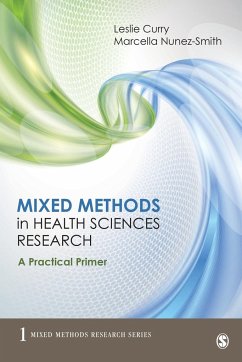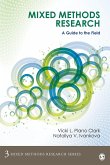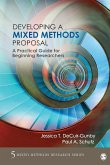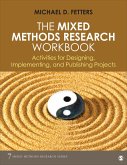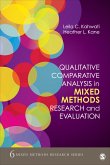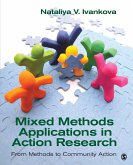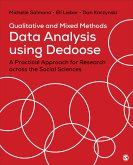- Broschiertes Buch
- Merkliste
- Auf die Merkliste
- Bewerten Bewerten
- Teilen
- Produkt teilen
- Produkterinnerung
- Produkterinnerung
Packed with illustrations from the health sciences literature, the book shows students how to design, conduct, review, and use mixed methods research findings. Throughout the book, real-world examples and insights from mixed methods researchers provide unique perspectives on every aspect of mixed methods research.
Andere Kunden interessierten sich auch für
![Mixed Methods Research Mixed Methods Research]() Vicki L. Plano ClarkMixed Methods Research73,99 €
Vicki L. Plano ClarkMixed Methods Research73,99 €![Developing a Mixed Methods Proposal Developing a Mixed Methods Proposal]() Jessica DeCuir-GunbyDeveloping a Mixed Methods Proposal73,99 €
Jessica DeCuir-GunbyDeveloping a Mixed Methods Proposal73,99 €![The Mixed Methods Research Workbook The Mixed Methods Research Workbook]() Michael D. FettersThe Mixed Methods Research Workbook79,99 €
Michael D. FettersThe Mixed Methods Research Workbook79,99 €![Using Mixed Methods Research Synthesis for Literature Reviews Using Mixed Methods Research Synthesis for Literature Reviews]() Mieke HeyvaertUsing Mixed Methods Research Synthesis for Literature Reviews73,99 €
Mieke HeyvaertUsing Mixed Methods Research Synthesis for Literature Reviews73,99 €![Qualitative Comparative Analysis in Mixed Methods Research and Evaluation Qualitative Comparative Analysis in Mixed Methods Research and Evaluation]() Leila KahwatiQualitative Comparative Analysis in Mixed Methods Research and Evaluation79,99 €
Leila KahwatiQualitative Comparative Analysis in Mixed Methods Research and Evaluation79,99 €![Mixed Methods Applications in Action Research Mixed Methods Applications in Action Research]() Nataliya IvankovaMixed Methods Applications in Action Research114,99 €
Nataliya IvankovaMixed Methods Applications in Action Research114,99 €![Qualitative and Mixed Methods Data Analysis Using Dedoose Qualitative and Mixed Methods Data Analysis Using Dedoose]() Michelle SalmonaQualitative and Mixed Methods Data Analysis Using Dedoose79,99 €
Michelle SalmonaQualitative and Mixed Methods Data Analysis Using Dedoose79,99 €-
-
-
Packed with illustrations from the health sciences literature, the book shows students how to design, conduct, review, and use mixed methods research findings. Throughout the book, real-world examples and insights from mixed methods researchers provide unique perspectives on every aspect of mixed methods research.
Hinweis: Dieser Artikel kann nur an eine deutsche Lieferadresse ausgeliefert werden.
Hinweis: Dieser Artikel kann nur an eine deutsche Lieferadresse ausgeliefert werden.
Produktdetails
- Produktdetails
- Mixed Methods Research Series
- Verlag: SAGE Publications Inc
- Seitenzahl: 432
- Erscheinungstermin: 20. Oktober 2014
- Englisch
- Abmessung: 229mm x 152mm x 23mm
- Gewicht: 626g
- ISBN-13: 9781483306773
- ISBN-10: 1483306771
- Artikelnr.: 40822040
- Herstellerkennzeichnung
- Libri GmbH
- Europaallee 1
- 36244 Bad Hersfeld
- gpsr@libri.de
- Mixed Methods Research Series
- Verlag: SAGE Publications Inc
- Seitenzahl: 432
- Erscheinungstermin: 20. Oktober 2014
- Englisch
- Abmessung: 229mm x 152mm x 23mm
- Gewicht: 626g
- ISBN-13: 9781483306773
- ISBN-10: 1483306771
- Artikelnr.: 40822040
- Herstellerkennzeichnung
- Libri GmbH
- Europaallee 1
- 36244 Bad Hersfeld
- gpsr@libri.de
Leslie Curry is an internationally-recognized expert in mixed methods research. For two decades, she has conducted extramurally-funded studies using these methods to examine health care delivery and quality in diverse settings and the scale up of health care innovations, with emphasis on translating her research into policy and practice. Leslie has extensive experience in teaching, mentoring, and consulting on qualitative and mixed methods with a wide range of researchers in the health sciences. She brings this experience to the book in order to include essential information needed to address the questions commonly asked by students and colleagues.
Part I: Mixed Methods 101
Chapter 1: Definition and Overview of Mixed Methods Designs
Definition and Characteristics of Mixed Methods Research
Key Factors in Mixed Methods Research Designs
Primary Mixed Methods Study Designs
Examples From Peer-Reviewed Published Literature
Chapter 2: Applications and Illustrations of Mixed Methods Health Sciences
Research
Relevance of Mixed Methods Research in the Health Sciences
Illustrations From Mixed Methods Studies in the Health Sciences
Chapter 3: Determining the Appropriateness and Feasibility of Using Mixed
Methods
Defining the Nature of the Research Question
Developing the Rationale and Aims for a Mixed Methods Study
Key Considerations at the Planning Stage of a Project to Determine
Feasibility
Part II: Getting Mixed Methods Research Funded
Chapter 4: Writing a Scientifically Sound and Compelling Grant Proposal for
a Mixed Methods Study
Before You Write
Trends in Funding for Mixed Methods Studies
Writing a Mixed Methods Proposal
Chapter 5: Examples of Funded Grant Applications Using Mixed Methods
Real-World Examples of National Institutes of Health Grant Applications
Tips From the Field
Chapter 6: Assessing Quality in Mixed Methods Studies
The Importance of Research Quality for Different Audiences
Common Standards of Quality in Qualitative and Quantitative Research
Additional Standards for Quality in Designing and Conducting Mixed Methods
Studies
Examples of Threats to Quality in the Design and Conduct of Mixed Methods
Studies
Part III: Designing and Implementing a Mixed Methods Study
Chapter 7: Sampling and Data Collection in Mixed Methods Studies
Principles of Sound Sampling
Principles of Sampling in Mixed Methods Studies
Practices of Sampling in Mixed Methods Studies
Approaches to Data Collection in Mixed Methods Studies
Chapter 8: Data Analysis and Integration in Mixed Methods Studies
Importance of Integration of Mixed Methods Data
Developing a Data Analysis Plan
Approaches to Integration in Data Collection and Analysis
Implementing Data Integration
Integration in Interpreting and Presenting Findings
Chapter 9: Managing Mixed Methods Teams
Why Think About Mixed Methods Teams?
Mixed Methods Teams as Representational Groups
Considerations and Guiding Principles for Managing Teams
Single Investigator Research
Chapter 10: Implementation Issues in Mixed Methods Research
Working With Human Research Protection Programs
Recommendations for Preparing a Strong Mixed Methods Application for Human
Research Protection Program Review
Key Issues for Specific Mixed Methods Design Types
Implementation Challenges and Strategies From the Field
Part IV: Disseminating Findings
Chapter 11: Publishing Mixed Methods Studies in the Health Sciences
Challenges and Opportunities in Publishing Mixed Methods Research in the
Health Sciences
Developing a Publication Strategy and Plan
Responding to Peer Reviews for Mixed Methods Studies
Example of Letter for Revision and Resubmission
Chapter 1: Definition and Overview of Mixed Methods Designs
Definition and Characteristics of Mixed Methods Research
Key Factors in Mixed Methods Research Designs
Primary Mixed Methods Study Designs
Examples From Peer-Reviewed Published Literature
Chapter 2: Applications and Illustrations of Mixed Methods Health Sciences
Research
Relevance of Mixed Methods Research in the Health Sciences
Illustrations From Mixed Methods Studies in the Health Sciences
Chapter 3: Determining the Appropriateness and Feasibility of Using Mixed
Methods
Defining the Nature of the Research Question
Developing the Rationale and Aims for a Mixed Methods Study
Key Considerations at the Planning Stage of a Project to Determine
Feasibility
Part II: Getting Mixed Methods Research Funded
Chapter 4: Writing a Scientifically Sound and Compelling Grant Proposal for
a Mixed Methods Study
Before You Write
Trends in Funding for Mixed Methods Studies
Writing a Mixed Methods Proposal
Chapter 5: Examples of Funded Grant Applications Using Mixed Methods
Real-World Examples of National Institutes of Health Grant Applications
Tips From the Field
Chapter 6: Assessing Quality in Mixed Methods Studies
The Importance of Research Quality for Different Audiences
Common Standards of Quality in Qualitative and Quantitative Research
Additional Standards for Quality in Designing and Conducting Mixed Methods
Studies
Examples of Threats to Quality in the Design and Conduct of Mixed Methods
Studies
Part III: Designing and Implementing a Mixed Methods Study
Chapter 7: Sampling and Data Collection in Mixed Methods Studies
Principles of Sound Sampling
Principles of Sampling in Mixed Methods Studies
Practices of Sampling in Mixed Methods Studies
Approaches to Data Collection in Mixed Methods Studies
Chapter 8: Data Analysis and Integration in Mixed Methods Studies
Importance of Integration of Mixed Methods Data
Developing a Data Analysis Plan
Approaches to Integration in Data Collection and Analysis
Implementing Data Integration
Integration in Interpreting and Presenting Findings
Chapter 9: Managing Mixed Methods Teams
Why Think About Mixed Methods Teams?
Mixed Methods Teams as Representational Groups
Considerations and Guiding Principles for Managing Teams
Single Investigator Research
Chapter 10: Implementation Issues in Mixed Methods Research
Working With Human Research Protection Programs
Recommendations for Preparing a Strong Mixed Methods Application for Human
Research Protection Program Review
Key Issues for Specific Mixed Methods Design Types
Implementation Challenges and Strategies From the Field
Part IV: Disseminating Findings
Chapter 11: Publishing Mixed Methods Studies in the Health Sciences
Challenges and Opportunities in Publishing Mixed Methods Research in the
Health Sciences
Developing a Publication Strategy and Plan
Responding to Peer Reviews for Mixed Methods Studies
Example of Letter for Revision and Resubmission
Part I: Mixed Methods 101
Chapter 1: Definition and Overview of Mixed Methods Designs
Definition and Characteristics of Mixed Methods Research
Key Factors in Mixed Methods Research Designs
Primary Mixed Methods Study Designs
Examples From Peer-Reviewed Published Literature
Chapter 2: Applications and Illustrations of Mixed Methods Health Sciences
Research
Relevance of Mixed Methods Research in the Health Sciences
Illustrations From Mixed Methods Studies in the Health Sciences
Chapter 3: Determining the Appropriateness and Feasibility of Using Mixed
Methods
Defining the Nature of the Research Question
Developing the Rationale and Aims for a Mixed Methods Study
Key Considerations at the Planning Stage of a Project to Determine
Feasibility
Part II: Getting Mixed Methods Research Funded
Chapter 4: Writing a Scientifically Sound and Compelling Grant Proposal for
a Mixed Methods Study
Before You Write
Trends in Funding for Mixed Methods Studies
Writing a Mixed Methods Proposal
Chapter 5: Examples of Funded Grant Applications Using Mixed Methods
Real-World Examples of National Institutes of Health Grant Applications
Tips From the Field
Chapter 6: Assessing Quality in Mixed Methods Studies
The Importance of Research Quality for Different Audiences
Common Standards of Quality in Qualitative and Quantitative Research
Additional Standards for Quality in Designing and Conducting Mixed Methods
Studies
Examples of Threats to Quality in the Design and Conduct of Mixed Methods
Studies
Part III: Designing and Implementing a Mixed Methods Study
Chapter 7: Sampling and Data Collection in Mixed Methods Studies
Principles of Sound Sampling
Principles of Sampling in Mixed Methods Studies
Practices of Sampling in Mixed Methods Studies
Approaches to Data Collection in Mixed Methods Studies
Chapter 8: Data Analysis and Integration in Mixed Methods Studies
Importance of Integration of Mixed Methods Data
Developing a Data Analysis Plan
Approaches to Integration in Data Collection and Analysis
Implementing Data Integration
Integration in Interpreting and Presenting Findings
Chapter 9: Managing Mixed Methods Teams
Why Think About Mixed Methods Teams?
Mixed Methods Teams as Representational Groups
Considerations and Guiding Principles for Managing Teams
Single Investigator Research
Chapter 10: Implementation Issues in Mixed Methods Research
Working With Human Research Protection Programs
Recommendations for Preparing a Strong Mixed Methods Application for Human
Research Protection Program Review
Key Issues for Specific Mixed Methods Design Types
Implementation Challenges and Strategies From the Field
Part IV: Disseminating Findings
Chapter 11: Publishing Mixed Methods Studies in the Health Sciences
Challenges and Opportunities in Publishing Mixed Methods Research in the
Health Sciences
Developing a Publication Strategy and Plan
Responding to Peer Reviews for Mixed Methods Studies
Example of Letter for Revision and Resubmission
Chapter 1: Definition and Overview of Mixed Methods Designs
Definition and Characteristics of Mixed Methods Research
Key Factors in Mixed Methods Research Designs
Primary Mixed Methods Study Designs
Examples From Peer-Reviewed Published Literature
Chapter 2: Applications and Illustrations of Mixed Methods Health Sciences
Research
Relevance of Mixed Methods Research in the Health Sciences
Illustrations From Mixed Methods Studies in the Health Sciences
Chapter 3: Determining the Appropriateness and Feasibility of Using Mixed
Methods
Defining the Nature of the Research Question
Developing the Rationale and Aims for a Mixed Methods Study
Key Considerations at the Planning Stage of a Project to Determine
Feasibility
Part II: Getting Mixed Methods Research Funded
Chapter 4: Writing a Scientifically Sound and Compelling Grant Proposal for
a Mixed Methods Study
Before You Write
Trends in Funding for Mixed Methods Studies
Writing a Mixed Methods Proposal
Chapter 5: Examples of Funded Grant Applications Using Mixed Methods
Real-World Examples of National Institutes of Health Grant Applications
Tips From the Field
Chapter 6: Assessing Quality in Mixed Methods Studies
The Importance of Research Quality for Different Audiences
Common Standards of Quality in Qualitative and Quantitative Research
Additional Standards for Quality in Designing and Conducting Mixed Methods
Studies
Examples of Threats to Quality in the Design and Conduct of Mixed Methods
Studies
Part III: Designing and Implementing a Mixed Methods Study
Chapter 7: Sampling and Data Collection in Mixed Methods Studies
Principles of Sound Sampling
Principles of Sampling in Mixed Methods Studies
Practices of Sampling in Mixed Methods Studies
Approaches to Data Collection in Mixed Methods Studies
Chapter 8: Data Analysis and Integration in Mixed Methods Studies
Importance of Integration of Mixed Methods Data
Developing a Data Analysis Plan
Approaches to Integration in Data Collection and Analysis
Implementing Data Integration
Integration in Interpreting and Presenting Findings
Chapter 9: Managing Mixed Methods Teams
Why Think About Mixed Methods Teams?
Mixed Methods Teams as Representational Groups
Considerations and Guiding Principles for Managing Teams
Single Investigator Research
Chapter 10: Implementation Issues in Mixed Methods Research
Working With Human Research Protection Programs
Recommendations for Preparing a Strong Mixed Methods Application for Human
Research Protection Program Review
Key Issues for Specific Mixed Methods Design Types
Implementation Challenges and Strategies From the Field
Part IV: Disseminating Findings
Chapter 11: Publishing Mixed Methods Studies in the Health Sciences
Challenges and Opportunities in Publishing Mixed Methods Research in the
Health Sciences
Developing a Publication Strategy and Plan
Responding to Peer Reviews for Mixed Methods Studies
Example of Letter for Revision and Resubmission

